Training in Team Sports: Optimising Training at FCB
*Corresponding author: Francesc Cos Morera cosfrancesc@gmail.com
Cite this article
Pons, E., Martín-Garcia, A., Guitart, M., Guerrero, I., Tarragó, J.R., Seirul·lo, F., Cos, F. (2020). Training in Team Sports: Optimising Training at FCB. Apunts. Educación Física y Deportes, 142, 55-66. https://doi.org/10.5672/apunts.2014-0983.es.(2020/4).142.07
Abstract
In the pursuit of sporting success, the main objectives in top-level sport include winning and improving results. The sport sciences constantly strive to apply new training methodologies and systems to enhance and maintain the performance of sportsmen and women. Team sports involve competitions held over long periods of time and also subject the athlete to high competitive stress. They therefore call for methods tailored to their specific features. The methodology called structured training is organised into two areas of action: coadjuvant and optimiser. This article expounds the foundations and the main facets of optimiser training. This publication is part of a set of three articles that explain the basics of the structured training method.
Introduction
Over the years, the improvement of sports performance in training has prompted the emergence of a number of methodological currents whose common denominator is sporting success. The advent of new theories brought a new training paradigm called structured training (ST), which pursues the all-round development of the sportsman or woman (Tarragó et al., 2019; Seirul·lo, cited by Ribera, 2009). This methodological trend has been innovative in team sports and is particularly relevant for football. Based on the principle that sport-specific training produces better performance adjustments, one of the objectives is to design training tasks which replicate the context and conditions of competition in order to achieve the best possible optimisation of the human athlete’s (HA) different structures (Pinder et al., 2011; Tarragó et al., 2019). Figure 1 shows the structures that comprise ST.
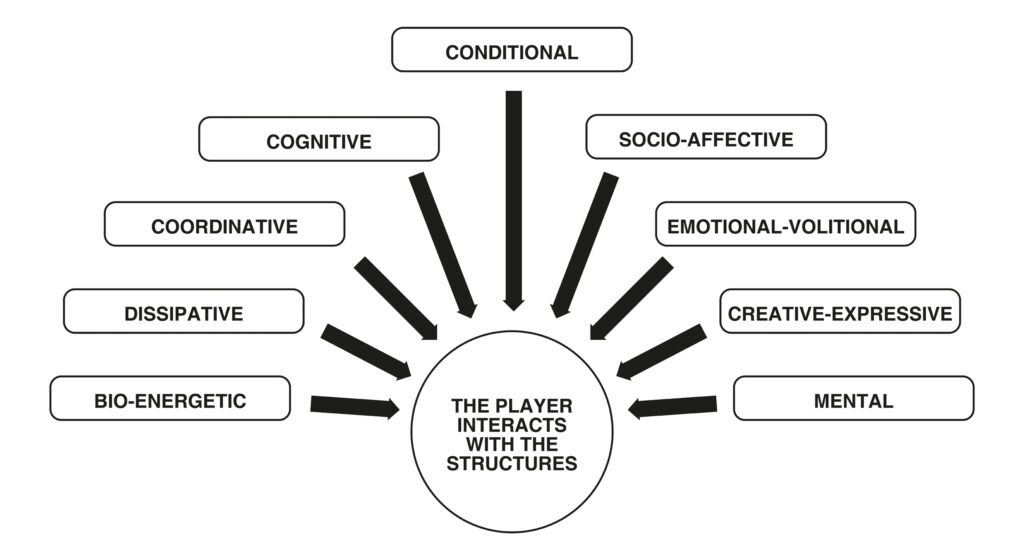
In recent decades, FC Barcelona has developed a training methodology for team sports anchored in what is called structured training (ST) (Seirul·lo, 1987; Tarragó et al., 2019), in turn rooted in an interest in the HA: “women and men who are involved in a game/sport who share with others a common interest in winning and in besting opponents to obtain compensation for the effort and dedication required by this objective” (Tarragó et al., 2019).
ST is organised on the basis of two paradigms or areas of action, known as optimiser training (OT) and coadjuvant training (CT) (Gómez, et al., 2019), two types of complementary training derived from the theory of complex non-linear dynamic systems (Hristovski et al., 2011; Balagué et al., 2014). From this new standpoint, training constitutes a single process of optimisation of the athlete, i.e. the individual is at the centre and it is therefore he or she who has the capacity to optimise their potential resources (Sánchez & Uriondo, 2012), which entails imbuing practices with a non-linear concept based on self-organisation and variability (Guerrero & Damunt, 2019).
The purpose of this article is to describe the key principles and aspects of OT as one of the two areas of action, together with coadjuvant training (Gómez et al., 2019) for HAs (Tarragó et al., 2019) developed for team sports at FC Barcelona (FCB).
Optimiser training
Optimiser training (OT) is “training that includes the planning, design, execution and control of the tasks of the sport in question and whose objective is the HA’s performance in all the competitions in which they participate throughout their sporting life” (Romero & Tous, 2010, foreword by Seirul·lo, paragraph 1); “We could say that this training essentially prepares HAs to compete and therefore requires training tasks to be performed in an environment and with elements that are specific to the game” (Tarragó et al., 2019, pp. 105-106), and it is performed primarily on the training ground or court.
Through practice, OT seeks to stimulate and develop the HA’s capacities through their structures consistently with their level of development and physical-cognitive maturation, while also taking positional specificity, chronological timing and the features which define the athlete into consideration. OT respects self-structuring and proposes various training tasks and stimuli in an appropriate way, thus consolidating the evolution of the HA and their optimal readiness for competition.
Preferential simulation situations
By using preferential simulation situations (PSSs), OT makes it possible to generate practical proposals that interact with and approach the sport being played. PSSs are about generating events and sets of situations conducive to a state of action and response in a created environment which encourages the imitation of behaviours that simulate the game/sport and preferentially impact the HA’s different constituent structures. This preference is achieved through the purpose of the task, which in turn is guided by means of rules, spaces and the number of participating players, which are variable and are tailored to suit the objective. These situations will be defined and extracted by the coaching staff and each player through the analysis and interpretation of the real game (Tarragó et al., 2019).
Given that the objective and foundations of ST are to measure the HA (Arjol, 2012), its practical approach delivers a high level of interaction in the competition of the sport in question. In this context, OT involves an exchange, cooperation and synergy between all the systems that constitute the HA’s structures, thereby fostering a different functional capacity which none of these structures separately possesses. This self-organisation corresponds to complex systems’ capacity to spontaneously form organisational patterns in the absence of information which imposes order. OT is therefore arranged in micro-structural units by the PSSs (Seirul·lo, cited by Ribera, 2009) and constitutes a specific and differential training practice for team sports.
Using these PSSs, the design of practice situations which are as close as possible to the reality of the game and its internal logic will be examined. This involves generating tasks in which the players have to resolve different situations continually, generating both voluntary and involuntary responses facilitated by extensive practice.
The term “simulation situation” refers to the reproduction of experiences and interactions of game events. The term “preferential situation” suggests the emphasis on or intention to optimise some of the HA’s structures. This preference yields a practical situation conceived to accomplish the objective of the session through highly-varied interactions with systems of other synergetic structures.
HAs’ characteristics and abilities will inform their training process whilst permitting the development of the structures being challenged by the PSSs. OT involves interactivity, cooperation and partnership between all the systems that make up the HAs’ structures. The PSSs will therefore be optimising for the HA and must be presented through global tasks executed preferably in groups and not for the purpose of learning/interpreting the exercise but rather the “game” (Seirul·lo, 2015). In this way, the athlete will be encouraged to focus on the dynamics of the “game” rather than on the rules involved in the task or the instructions of the coaching staff, thereby avoiding not only “playing according to the rules” but also “playing in the content”, thus fostering “playing in the context” (Guerrero & Damunt, 2019).
Each PSS calls for the involvement of the HA’s different systems or structures which the coach will have to identify. Each player has to bring into play the systems that best respond to the situation created based on their own lifelong self-organisation process. Each HA will deal with this by optimising in a distinct way. OT is about not restricting the exchange of practice with the HA by making it easier to identify basic specific sources of information, such as the determination of the conditional characteristics of the dominant leg, preferential co-ordination patterns in shooting, preferred communication channels, etc., but rather encourages pursuing the attainment of a higher hierarchical level of cognition, relating this intervention to the player’s hypercomplexity, for example by addressing the socio-affective dimension, helping them to identify preferential relationships when sharing a mutual intervention/assistance space with a particular teammate.
In recent years, the growing interest in studying the complexity of living organisms and their self-organisation has led to non-linear approaches to learning. It would appear that repeating tasks under the same conditions of practice does not produce the necessary “fluctuations” in the systems involved in order to change their state. Instead, models based on the approach of “constantly changing tasks” through a “variation” in the execution conditions would yield the disruptions required to lead to a change of functionality in the systems involved (Schöllhorn, et al., 2012; Balagué et al., 2014). With introjection and feedback, all the structures that make up the HA can be optimised, provided that this is done in “repetitions and variations” (Schöllhorn et al., 2015). Consequently, variability and specificity in the stimuli must be prioritised so that the HA can manage them, taking the HA as both a means and an end (Tarragó et al., 2019).
Several authors have classified PSSs by determining a task organisation based on different levels of approaching, specificity and/or concreteness (Moras, 1994; Schelling & Torres-Ronda, 2016; Seirul·lo, 2009). Seirul·lo (1998) classifies strength exercises according to their orientation and level of approach to competition, categorising them as general, targeted, special and competitive. This relationship with specificity in OT is established through the nature of the PSSs, distinguishing them by their general orientation: the nature and organisation of the PSS are similar to those of competition, albeit with a low specific cognitive load; targeted orientation: the nature and organisation of the PSS are similar to competition. This includes specific coordinated actions with non-specific decision-making with a special orientation: the nature and organisation of the PSS are similar to competition with specific decision-making; and competitive orientation: the nature and organisation of the PSS are the same as competition with totally specific decision-making (Solé, 2006).
Conjectures in the preparation of PSSs in OT
PSSs conform the training sessions of the training cycle, which in turn represents the functional unit of ST organisation. This functional unit is called the structured micro-cycle (SM) and manages the cycle between matches. Each micro-cycle interacts with the previous and the following micro-cycle to form sequences of three micro-cycles. Dynamics are established between them in the form of functional relationships between the PSSs of each training day that make up the SM. These relationships are brought about by valid “conjectures” in the configuration of the ST (Seirul·lo, 2015). They are the concepts and assertions supported by signs, observations, symptoms and opinions extracted from the practice of the OT, once it has been accepted and understood that its validity is shaped by the knowledge contributed by the complexity sciences (Arjol, 2012).
The conjectures that determine the preparation of the PSSs are:
Time efficiency conjecture: defined as the time it takes for a PSS to induce the intended optimising effect on the HA, known as the “shift effect”. As the time available in the training sessions is limited, each action is designed to foster efficiency and quality in effort management.
Synergistic conjecture: this refers to the effect achieved by the combination of actions. These synergetic effects are produced between the components of successive PSSs performed in the same session (synchronously) and also across successive sessions (diachronically) within the SM. When a change is sought in the HA, one also talks about the intersystemic effect, to with a system open to the outside world through projection and introjection mechanisms. It is precisely this form of relationship that is called intersystemic when any optimising effect of a system expands its change to other systems of the high structures involved simultaneously.
Suitability conjecture: this refers to the aptitude, good predisposition or capacity that someone has for a specific, adequate and appropriate purpose. The PSSs should be presented in a suitable way to achieve the improvement of the HA in terms of the game’s demands. When generating the PSSs it is crucial to identify what is specific and unique to the speciality in which the training is performed in order to understand it in all its entirety and complexity.
Hologrammatic conjecture: this configures the PSSs in OT. It is defined as perceptive capacity (from mind to consciousness) with the ability to capture and gather information that is present, is produced or may be produced during the game. In OT there need to be PSSs where the HA captures and recognises all the situations addressed to acquire them in order to be able to cope with the complexity of the game as efficiently as possible. Figure 2 shows the situations that shape the production of PSSs.

Preferential simulation situations
Situation
The PSSs are located in a context that sets up action and response in a game/sport environment comprised of all the elements involved: the athlete, their teammates, opponents, the moment when the action is created, etc. (Balagué et al., 2014). The tasks are global, in groups, and various time sequences are proposed which are integrated into the complex context of the game (Pol, 2014).
Another key aspect is the specificity of the PSSs used in training. The concept of “specificity” refers to the kind of elements that are specific to a given sports speciality as well as to a specific situational sensitivity on the part of the player as the “own micro-environment” of this game/sport during competition (Tarragó et al., 2019). Drawing on the ST proposal, competition is the event in which all the structures of the HA are most intensively activated, hence the PSSs with the greatest number of stimulated structures within an environment similar to the actual game will have greater specificity.
In recent years there has been growing interest in the complexity of nature and change, which are based on a non-linear understanding of causality, whereby small causes can generate major effects and vice versa (Moras et al., 2018; Tarrago et al., 2019). The PSSs addressed under these criteria not only maintain their essential nature for learning but also become more attractive in practice due to the constant challenge they pose to the HA.
Variability as the basis of OT is the ability to change training conditions to trigger new response learnings so that through these variations the athlete has to adapt their performance and establish new parameters for speed, path, strength, etc. (Schmidt, et al., 2018). This learning is therefore another characteristic element based on the constant resolution of new and varied situations without losing its appearance or preferential objective (Hristovski, et al., 2011). The repetition of specific disturbances typical of the game and of “our game” should be facilitated and can be modified by reducing the degrees of freedom and by means of conditioning and/or constraints (facilitating contexts rather than simplifying them), albeit by means of variable execution. As a complex dynamic system, the player will constantly find themselves in changing contexts to which they will have to adapt continuously. This means the motor behaviour or action to be optimised will not be inflexible and nor will it attempt to follow a pre-established model (Guerrero & Damunt, 2019) while reducing the inherently harmful rate of repetitive practices and increasing the associated creativity. “Adaptability as a product of variability is closely tied to creativity” (Orth et al., 2017).
Simulator
The “simulator” concept refers to the need to use the practical proposal to reproduce the elements typical of the game and which reproduce competition and its specific demands (Balagué et al., 2014). The qualitative orientation of the proposed exercises should be borne in mind in order to convey information that can be identified as having significant value and efficiency for the self-optimisation of the HA (Pol, 2014). The impact on top-level team sports players is usually high.
The use of simulator situations makes it possible to generate exercises of varying specificity or approaching level to the demand (Schelling & Torres-Ronda, 2016), which is related to the planning and control of the PSSs; an adaptation of the load throughout the season helps to plan and generate sequences based on the coach’s needs.
Preferential
The “preferential” concept refers to managing the elements of the PSSs in order to distinguish a structure that conforms the HA in the context of OT. This priority leads to a practical situation intended to achieve the objective of the session, i.e. to afford preference/priority to one or more specific structures. This does not mean that this preferential structure rules out any relationship with the others, since the great variety of the game allows interrelationships (Pol, 2014).
It is essential to view the PSSs as a differentiated source of requirements so that even if the same task is proposed for a group of players it does not involve the same level of demands on each one of them; levels of demands have to be adjusted to suit the HA’s configuration/shape, bearing in mind specific modifications tailored to individual needs to enable better self-optimisation of each player.
Specific qualities of OT
The distinctive behaviour of each type of sport is determined by the inherent characteristics of the sport/game in question (Seirul·lo, 1998). When considering specific qualities (SQ), a complex relationship is established between the HA’s systems which is carried out with movement, through the application of muscle strength. “Strength” means the basic physical quality from which the other qualities are expressed since it is the generator of movement.
OT of the SQs is based on a methodological proposal adapted from Moras (1994), Seirul·lo (1998), Schelling and Torres-Ronda (2016) and Gómez et al. (2019), proposing a breakdown of the game into work areas, contents and alternative training of these contents in accordance with their orientation and the approaching levels that can be attained by promoting each player’s technical execution levels (Gómez et al., 2019).
The “work areas” are determined by the four specific expressions of strength required in football and team sports in general: displacement, jump, fight and ball action strength, as depicted in Figure 3 (Gómez et al., 2019; modified from Schelling & Torres-Ronda, 2016).

The PSS proposal in OT includes all the HA’s structures, conditioned by the interpretation of the game and the rules of the sports speciality that determine the dominant motor skills and the interactions between teammates, opponents and the environment (Seirul·lo, 1998); all these aspects are strongly influenced by the methodological proposal and the game model implemented by the coaching staff.
The integration of technology into the dynamics of professional teams has made it possible to accurately ascertain conditional characteristics by studying the external and internal load experienced by athletes throughout training and competition (Castellano et al., 2011). Examples include geolocation systems known by the EPTS (Electronic Performance and Tracking Systems) initialism and the semi-automatic, multiple-camera System Technology (VID) tracking systems used in games in La Liga, the Champions League and other competitions. These technological systems make it possible to monitor the actions of the game and to track load based on different conditional variables, thereby simplifying the planning of training units and PSS design. The most recent evolutionary studies of competitive analysis show a significant increase in external load due to high-intensity actions (metres covered at high intensity, number of accelerations, etc.). The relevant information gathered allows objective and efficient action to be taken through OT in response to the needs of the sportsperson vis-à-vis competition. The use of this technology allows the description of the SQs and their behaviour in OT. In line with the suggestion made by Gómez et al., (2019), the expression of strength in all SQs as part of OT and the degree of presence in the performance of sports in shared spaces are presented below (Figures 4,5,6 and 7).
Systems that make up optimiser training of specific qualities. The transition from football to other team sports
Displacement
OT for displacement strength SQ is comprised of all actions on and off the ball, of variable duration and intensity, in which displacement takes place. It includes all types of running (forward, sideways or backwards), changes of direction, turns, feints, accelerations, decelerations, braking, etc., in which the basic principles of the movements focus on precision and on the efficient application of a certain strength in an optimal space and time (Gómez et al., 2019). One of the distinctive aspects with respect to CT and which impacts the SQs is the need to adapt to a changing environment generated by the interactions between teammates, opponents and a ball that alters these relationships continuously.
The implementation of GPS technology makes it possible to identify the speed and amount of displacement of players in regular training and competition. This “intensity” has been classified in several speed ranges in order to evaluate the locomotor conditional demand. By way of example, in a number of football studies (Pons et al., 2019), displacement speed has been categorised in ranges from 0 to 6, 6 to 12, 12 to 18, 18 to 21, 21 to 24 and above 24 kph. Another measurable aspect is the athlete’s actions when accelerating or decelerating, which are also expressed in different ranges (Akenhead, et al. 2013). These variables are very important in team sports and are directly related to the HA’s neuromuscular structure (Loturco, et al., 2018).
To develop the displacement SQ, a number of game conditions must be considered, affording preference to each one of the situations involved in the sports speciality. The actions which determine the displacement SQ, depicted in Figure 4, are: changes of rhythm (accelerations and decelerations); displacement speed, changes of direction and changes in amplitude and frequency of supports, all of them adapting to the interaction with the environment, opponents and teammates, giving priority to the HA’s conditional efficiency.
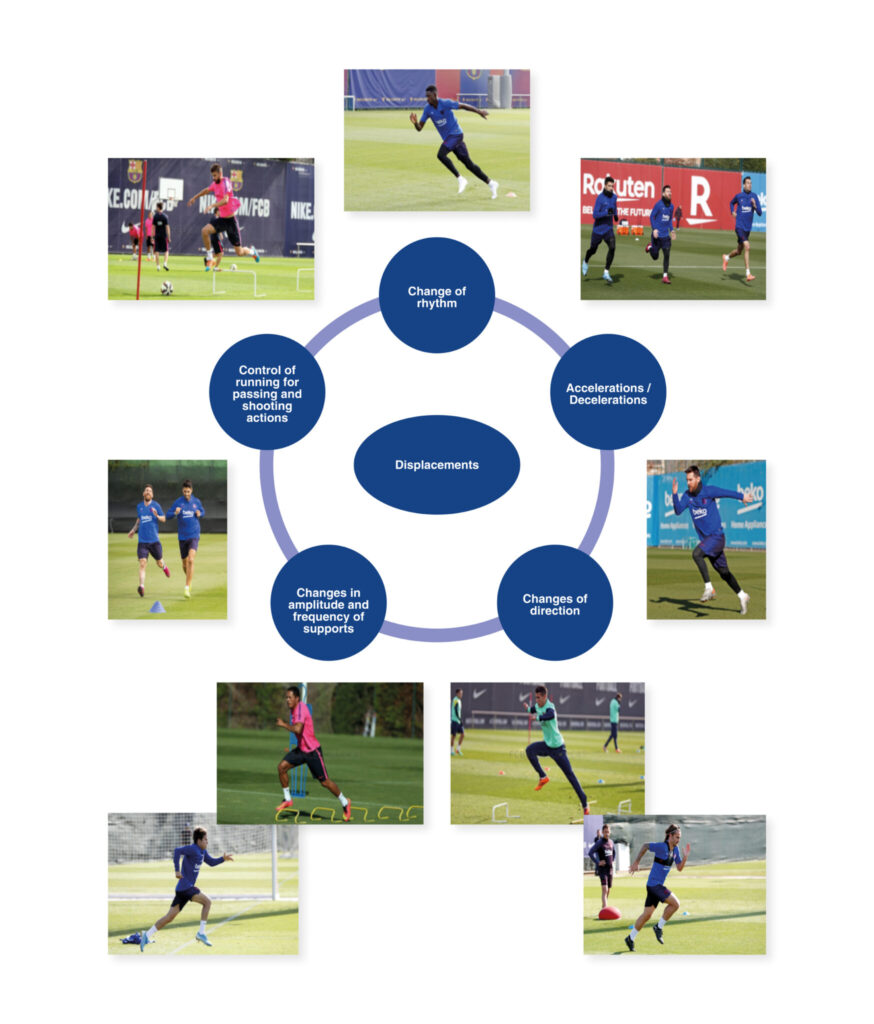
Fight
The fight strength SQ is comprised of all actions on and off the ball, of variable duration and intensity, in which at least two players contest a position or path using part or all of their body to win out, such as ball protection, charging, tackling, losing a marker or fighting to gain a position (Gómez et al., 2019).
Figure 5 shows different actions (before, during and after) to enable the management of the different PSSs, providing variability in fight strength actions. The situations that occur in each sport speciality call for a different application of strength (Seirul·lo, 1998). OT seeks to generate specific stimuli adapted to the sport and each HA based on individual characteristics and taking the positional role into account.
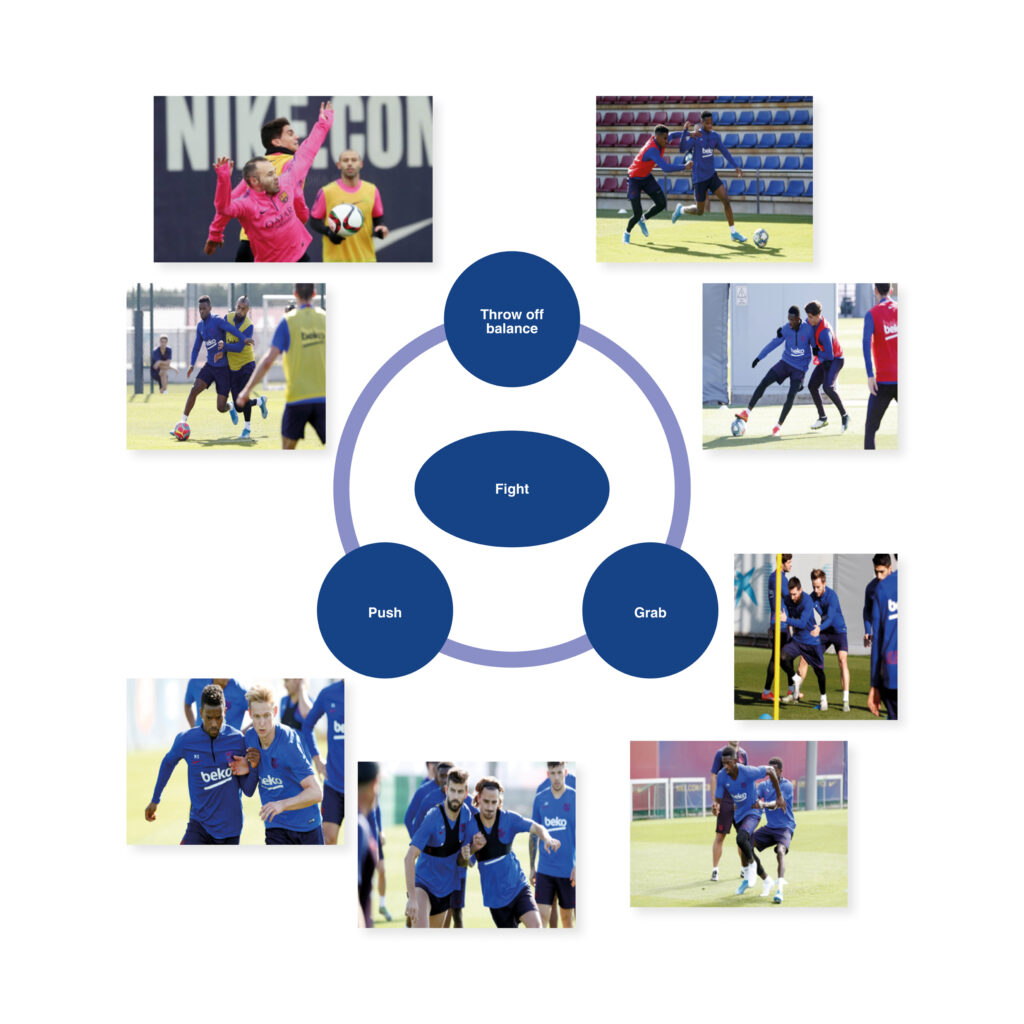
Jump
OT for the jump strength SQ is comprised of all actions on and off the ball, of variable duration and intensity, in which there is a jump; this initial thrust can be one- or two-footed, stationary or moving, where the body goes into the air and with a greater incidence in vertical displacement (Gómez et al., 2019).
As an SQ included within the complexity of the game, jumping should be considered as a training component of OT although it is also addressed in CT. Each sport has its own specific jumping characteristics, and consequently game situations in which there are actions in the air (heading and clearances), drives and receptions should be categorised with the diversity of situations appropriate to each sport while taking into account the individual characteristics of the HA.
Figure 6 shows different actions (before, during and after) and their variability in jump strength actions.
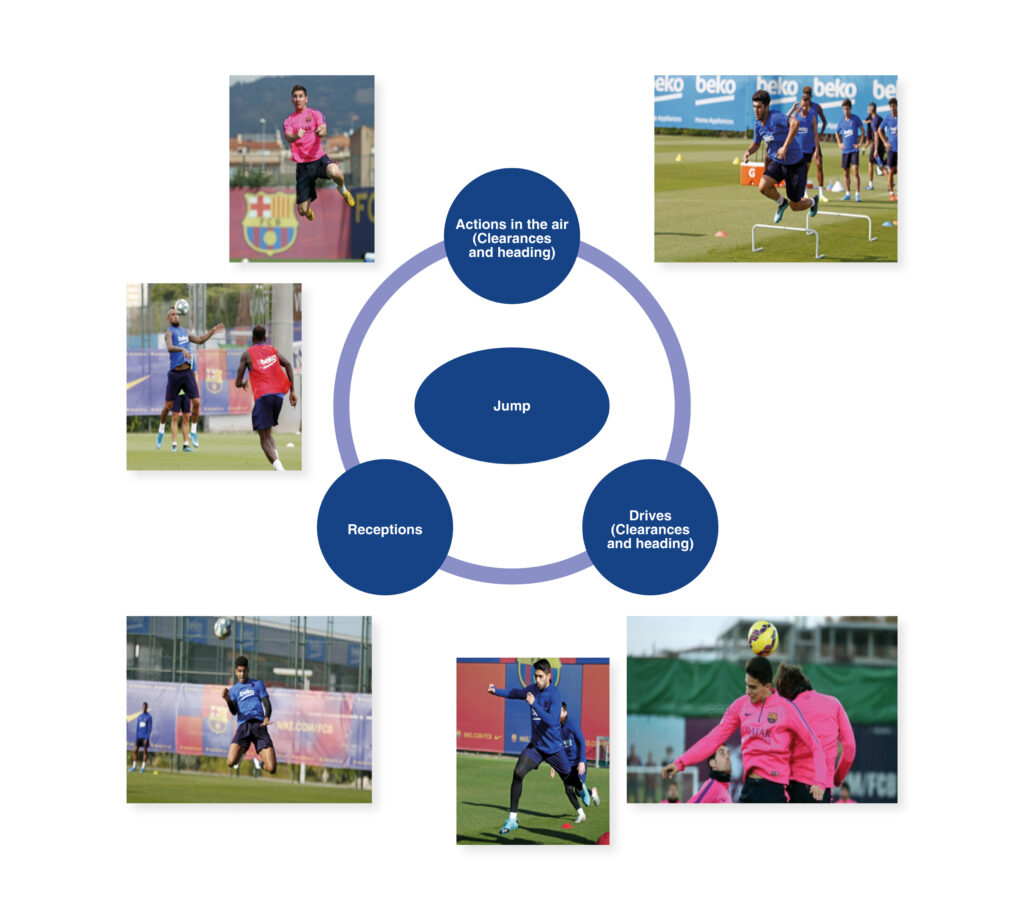
On-the-ball action
OT for the on-the-ball action strength SQ is comprised of all actions on and off the ball, of variable duration and intensity, in which there is contact with the ball, such as control, dribbling, passing, shooting, clearances, headers, etc. (Gómez et al., 2019).
The action the HA performs on the object varies according to the specificity of each sport when game actions are performed. In terms of on-the-ball actions, passing, kicking and shooting actions, conditioned by the interaction with teammates, opponents and the relationship space, must be taken into consideration.
Figure 7 shows different actions (before, during and after) and their variability in on-the-ball strength actions. Finally, Table 1 is a summary of the specific qualities and approaching levels.
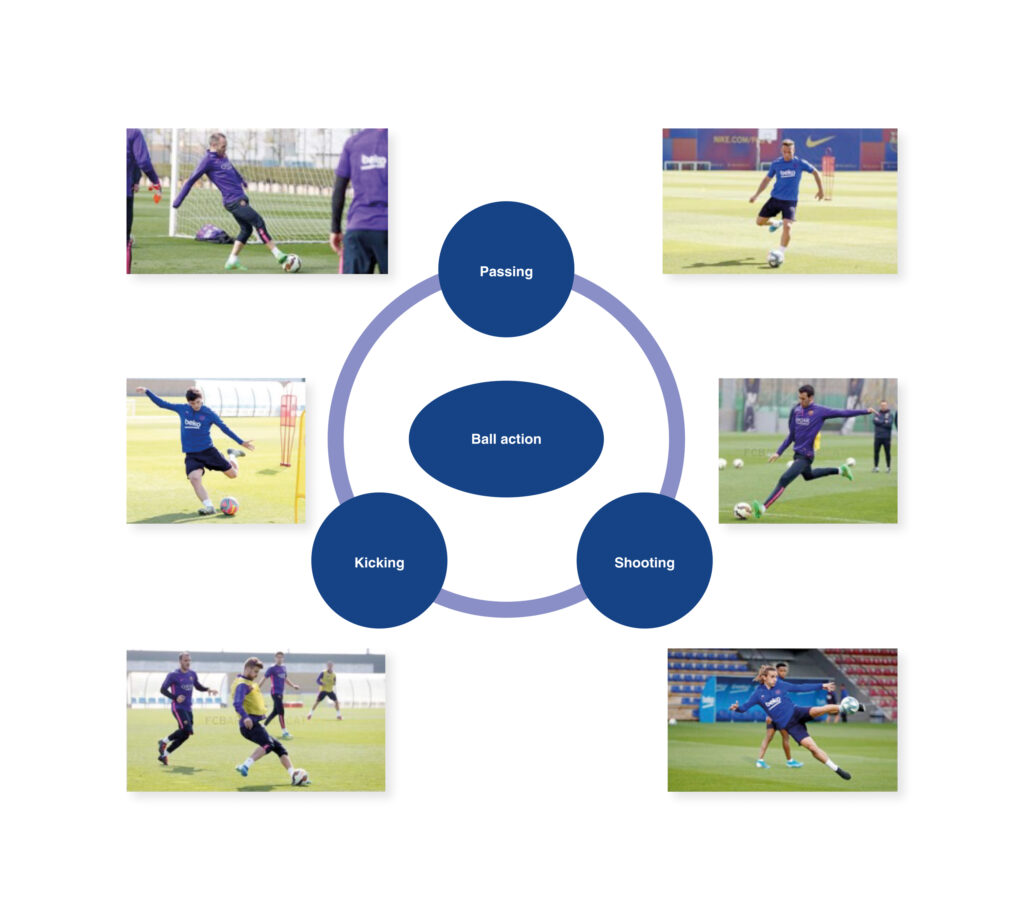

Future studies and ongoing research should enable further progress in using training methodologies and systems tailored to team sports. The implementation of new technologies for tracking both external and internal loads will make it easier to shape micro-cycles and session and task design based on objective data and criteria. Similarly, research into the relationship between complex systems and sports should be continued in order to buttress strategies which boost their applicability to team sports training and be able to cater to the individual characteristics of HAs.
References
[1] Akenhead, R., Hayes, P. R., Thompson, K. G., & French, D. (2013). Diminutions of acceleration and deceleration output during professional football match play. Journal of Science and Medicine in Sport, 16(6), 556-561. doi.org/10.1016/j.jsams.2012.12.005
[2] Arjol, J. L. (2012). La planificación actual del entrenamiento en fútbol.: Análisis comparado del enfoque estructurado y la periodización táctica. Acción motriz, (8), 27-37. ISSN-e 1989-2837
[3] Balagué, N., Torrents, C., Pol, R., & Seirul·lo, F. (2014). Integrated Training. Dynamic principles and applications. Apunts. Educación Física y Deportes, 116, 60-68. doi.org/10.5672/apunts.2014-0983.es.(2014/2).116.06
[4] Castellano, J., Casamichana, D., Calleja-González, J., San Román, J., & Ostojic, S. M. (2011). Reliability and accuracy of 10 Hz GPS devices for short-distance exercise. Journal of sports science & medicine, 10(1), 233-234.
[5] Gómez, A., Roqueta, E., Tarragó, J.R., Seirul·lo, F., & Cos, F. (2019). Training in Team Sports: Coadjuvant Training in the FCB. Apunts. Educación Física y Deportes, 138, 13-25. doi.org/10.5672/apunts.2014-0983.es.(2019/4).138.01
[6] Guerrero, I., Damunt, X. (2019). Methodological, pedagogical and didactic exchange with the player. Optimization of the decision-making system in youth football. Universidad católica de Valencia. Actividad Física y Deporte: Ciencia y Profesión, 31, 19-23. Edición especial, E-ISSN:2659-8930. www.ual.es/application/files/8615/6896/5946/Union_Memorias_Departamentos.pdf
[7] Hristovski, R., Davids, K. Araújo, D., & Passos, P. (2011). Constraints-induced emergence of functional novelty in complex neurobiological systems: A basis for creativity in sport. Nonlinear Dynamics, Psychology and Life Sciences, 15(2), 175-206.
[8] Loturco, I., Jeffreys, I., Kobal, R., Abad, C. C. C., Ramirez-Campillo, R., Zanetti, V., Pereira, L. A., & Nakamura, F. Y. (2018). Acceleration and speed performance of Brazilian elite soccer players of different age-categories. Journal of human kinetics, 64(1), 205-218. doi:10.1515/hukin-2017-0195
[9] Moras, G. (1994). La preparación integral en el Voleibol. Paidotribo: Barcelona.
[10] Moras, G., Fernández-Valdés, B., Vázquez-Guerrero, J., Tous-Fajardo, J., Exel, J., & Sampaio, J. (2018). Entropy measures detect increased movement variability in resistance training when elite rugby players use the ball. Journal of science and medicine in sport, 21(12), 1286-1292. doi.org/10.1016/j,jsams.2018.05.007
[11] Orth, D., van der Kamp, J., Memmert, D., Savelsbergh, GJP. (2017). Creative Motor Actions As Emerging from Movement Variability. Front Psychol. 8;1903. doi.org/10.3389/fpsyg.2017.01903
[12] Pinder, A., Davids, K., Renshaw, I., Araújo, D. (2011). Representative learning design and functionality of research and practice in sport. J Sport Exerc Psychol, 33(1):146–155. doi.org/10.1123/jsep.33.1.146
[13] Pol, R. (2014). La Preparación ¿Física? en el fútbol. Barcelona, España: Futbol del libro.
[14] Pons, E., García-Calvo, T., Resta, R., Blanco, H., López del Campo, R., Díaz García, J., & Pulido, J. J. (2019). A comparison of a GPS device and a multi-camera video technology during official soccer matches: Agreement between systems. PloS one, 14(8):e0220729. doi.org/10.1371/journal.pone.0220729
[15] Ribera, D. (2009). Planificación a largo plazo en los deportes col·lectivos. Apuntes de Seirul·lo. Revista de Entrenamiento Deportivo, RED, 23(4), 21-38. ISSN 1133-0619.
[16] Romero, D., & Tous, J. (2010). Prevención de lesiones en el deporte. Claves para un rendimiento deportivo óptimo. Madrid, España: Panamericana.
[17] Sánchez, J. M., & Uriondo, L. F. (2012). Aplicación de la teoría de los sistemas dinámicos al entrenamiento deportivo: fútbol. EF Deportes. com, Revista Digital, (165).
[18] Schelling, X., & Torres-Ronda, L. (2016). An integrative approach to strength and neuromuscular power training for basketball. Strength & Conditioning Journal, 38(3), 72-80. doi.org/10.1519/SSC.0000000000000219
[19] Schmidt, R. A., Lee, T. D., Winstein, C., Wulf, G., & Zelaznik, H. N. (2018). Motor control and learning: A behavioral emphasis (6.ª ed.). Champaing, IL: Human kinetics. lccn.loc.gov/2017048249
[20] Schöllhorn, W. I., Hegen, P. & Davids, K. (2012). The Nonlinear Nature of Learning – A differential Learning Approach. The Open Sports Sciences Journal, 5,Supple1-M11, 100-112. doi.org/10.2174/1875399X01205010100
[21] Schöllhorn, W. I., Eekhoff, A. & Hegen, P. (2015). Systemdynamik und differenzielles Lernen. Sportwissenschaft e-publication ahead. doi.org/10.1007/s12662-015-0366-z
[22] Seirul·lo, F. (1987). Opción de planificación de los deportes de largo período. Revista de Entrenamiento Deportivo RED, 1(3), 53-62.
[23] Seirul·lo, F. (1998). Planificación a largo plazo en los deportes col·lectives (ponència). Ponencias sobre entrenamiento deportivo en la infancia y la adolescencia. Escuela Canaria del Deporte. Dirección General de Deportes del Gobierno de Canarias. Canarias, España. www.motricidadhumana.com/seirul_planif_dep_colectivos.pdf
[24] Seirul·lo, F. (2015). Entrenamiento Estructurado. II Congreso internacional de optimización del entrenamiento y readaptación fisico-deportiva. Sevilla.
[25] Solé, J. (2006). Planificación del entrenamiento deportivo. Barcelona, España: Sicropat Sport.
[26] Tarragó, J.R., Massafred-Marimón, M., Seirul·lo, F., & Cos, F. (2019). Training in Team Sports: Structured Training in the FCB. Apunts. Educación Física y Deportes, 137, 103-114. doi.org/10.5672/apunts.2014-0983.es.(2019/3).137.08
ISSN: 2014-0983
Received: 5 March 2020
Accepted: 15 June 2020
Published: 1 October 2020
Editor: © Generalitat de Catalunya Departament de la Presidència Institut Nacional d’Educació Física de Catalunya (INEFC)
© Copyright Generalitat de Catalunya (INEFC). This article is available from url https://www.revista-apunts.com/. This work is licensed under a Creative Commons Attribution-NonCommercial-NoDerivatives 4.0 International License. The images or other third party material in this article are included in the article’s Creative Commons license, unless indicated otherwise in the credit line; if the material is not included under the Creative Commons license, users will need to obtain permission from the license holder to reproduce the material. To view a copy of this license, visit https://creativecommons.org/licenses/by-nc-nd/4.0/deed.en



